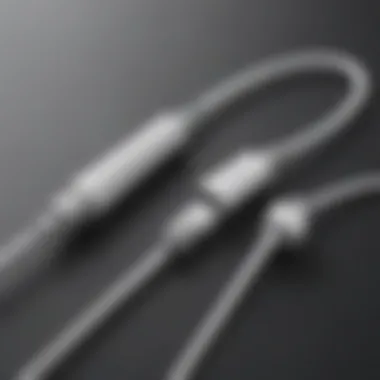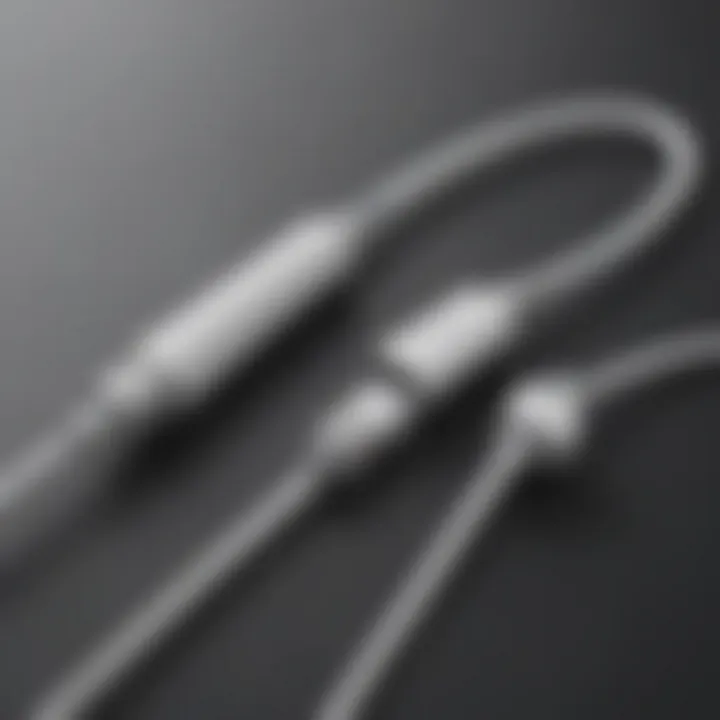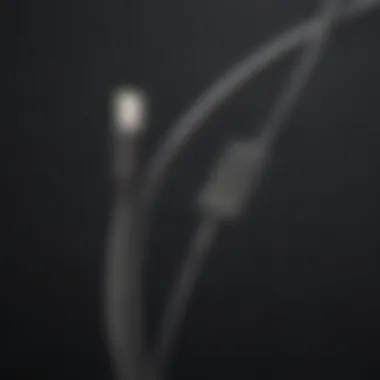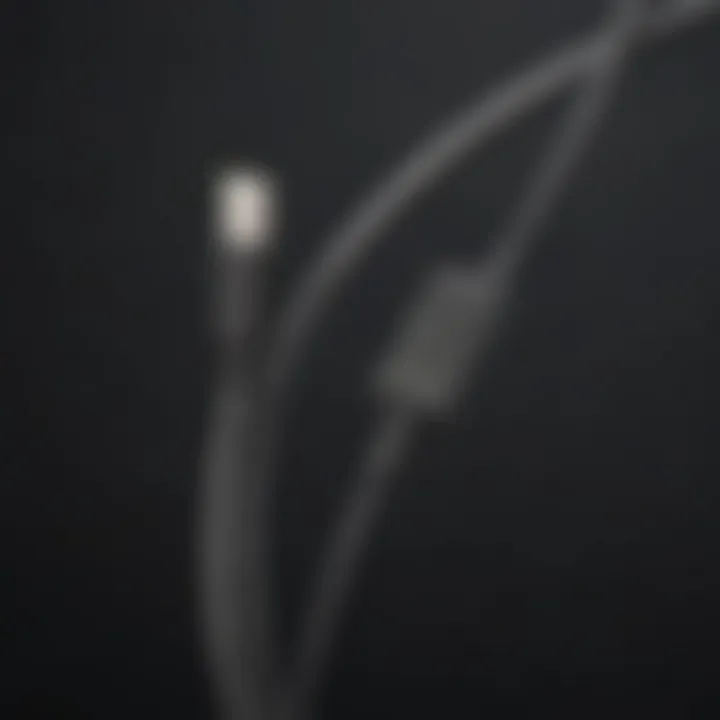Understanding Apple Certified iPhone Cords: Quality and Value


Product Overview
Apple certified iPhone cords are more than just simple accessories; they are a critical component in ensuring the functionality and longevity of devices. These cords are designed to meet specific standards set forth by Apple, emphasizing quality and reliability. Understanding these cords is essential for users who depend on their devices daily.
Prologue to the Apple product being discussed
In this article, we will explore the characteristics and importance of Apple certified cords. These include the Lightning to USB cable and the more recent USB-C options that have emerged as Apple embraces USB-C across its product range. Apple certified cords are built to work seamlessly with all compatible devices under the Apple umbrella, including iPhones, iPads, and select MacBooks.
Key features and specifications
Apple certified cords come with several distinct features:
- MFi Certification: Only cords that meet Apple's Made for iPhone (MFi) standards earn this certification, which ensures that they are safe to use.
- Durability: The materials used in these cords are often more robust compared to generic products, leading to a longer lifespan.
- Compatibility: Apple cords are designed to work with a wide array of devices, eliminating concerns about mismatched connections.
Design and aesthetics
The design of Apple certified cords typically adheres to minimalistic principles, complementing the aesthetics of Apple devices. With a white or black finish and solid connectors, these cords blend well with the sleek design philosophy that is a hallmark of Apple products.
Performance and User Experience
The performance of Apple certified iPhone cords truly sets them apart.
Performance benchmarks
Users can expect optimal charging speeds when using certified cables. Depending on the device and the charging block’s capability, most cords allow for quick charging, an essential feature in today's fast-paced world.
User interface and software capabilities
Using Apple certified cords ensures that users don’t encounter connectivity problems or data transfer issues. These cords are specifically designed to work with the proprietary systems of iOS, providing a smooth user experience.
User experiences and feedback
Many users report a significant difference in performance when comparing Apple cords to third-party alternatives. The assurance of durability and performance reliability is frequently noted, especially under heavy use conditions.
Comparison with Previous Models or Competitors
When analyzing the landscape, it is important to consider how Apple certified cords measure up against older models and competitor products.
Advancements and improvements from previous models
In previous iterations of iPhone models, users often relied on standard USB cords. With improvements in materials and technology, Apple has significantly enhanced the charging efficiency of its newer certified cords.
Competitive analysis with other similar products
Third-party cords may seem appealing due to lower price points. However, they often lack the stringent testing and quality control that Apple applies to its certified products. The differences in longevity, charging speed, and safety make a closer inspection worthwhile.
Value proposition
Investing in Apple certified cords may seem like a higher upfront cost, but the benefits often justify the price. The longevity and compatibility ensure that users save money in the long run by not needing to replace cords frequently.
Tips and Tricks
To enhance the experience with Apple cords, consider these practical guidelines:
How-to guides and tutorials for optimizing the Apple product's performance
Using Apple cords correctly involves straightforward practices. For example, avoid bending or twisting the cables at sharp angles to prolong their life.
Hidden features and functionalities
Many iPhone users may not know that certain Apple cords support Quick Charge features, significantly reducing charging time with compatible adapters.
Troubleshooting common issues
If users encounter problems, checking for debris in the Lightning port or using different wall adapters can often remedy them.
Latest Updates and News
Apple consistently evolves its product lines and their associated cords. Staying informed of these changes can enhance user experiences.
Recent developments in software updates and new features
Many recent iOS updates come with features that improve the interaction between devices and certified cords. Users should regularly check for updates to maximize their experience.
Industry news and rumors surrounding upcoming products
As Apple tends to innovate annually, rumors about new cords or standards often circulate. Following tech news can give users insights into what to expect.
Events and announcements from Apple
Key announcements from Apple events provide valuable insights into any upcoming changes regarding accessories, such as cords. Follow trusted sources to stay current.
Understanding Apple Certification
Apple certification plays a crucial role in ensuring that products meet specific standards of quality and performance. For iPhone charging cords, this certification guarantees not just compatibility but also safety and efficiency. The significance of this topic extends beyond mere compliance with Apple’s stringent requirements. It embodies consumer trust in the product they purchase.
Apple's certification process validates that accessories can interact seamlessly with various iPhone models. This interaction is paramount as it directly impacts user experience. By ensuring that the cords are certified, manufacturers can reassure consumers that their devices won't suffer from power issues or compatibility conflicts.
Understanding Apple certification also informs buyers about their investment. Certified cords usually command a higher price but offer additional durability and safety. Consumers can avoid the pitfalls associated with third-party charging cords, such as overheating or data transfer issues. This knowledge empowers buyers to make informed decisions aligned with their needs.
What Does Apple Certified Mean?
When a product is labeled as "Apple Certified," it indicates that it has undergone rigorous testing and evaluation processes established by Apple. This certification is often referred to as MFi, which stands for "Made for iPhone/iPad/iPod." Essentially, those products have passed specific criteria for performance and safety established by Apple Inc.
Apple certified cords are designed to work flawlessly with Apple devices. They include features that ensure efficient charging and high-speed data transfer, all while adhering to safety standards that prevent issues such as short circuits and overheating. It's important to note that such cords are manufactured under strict quality control, making them a reliable choice for users.


The Importance of MFi Certification
MFi certification stands as a hallmark of quality in the accessory market. The acronym MFi represents a program that Apple created to officially authorize accessory manufacturers to create products that connect with their devices. Such certification encompasses several elements that directly benefit users.
- Quality and Reliability: MFi-certified cords are less likely to fail compared to non-certified alternatives. This reliability is critical for users who depend on consistent performance.
- Safety Standards: MFi certification ensures that accessories adhere to Apple's safety protocols. Non-certified cords often lack these safeguards, increasing the risk of device damage.
- Data Integrity: Certified cables ensure that data transmission remains secure and stable. They help in preventing sync problems and data corruption issues that can arise with lower quality products.
In summary, understanding Apple certification, particularly MFi certification, leads to more informed consumer choices, ensuring that the accessories purchased not only comply with technical requirements but also enhance the overall experience with Apple products.
"Investing in Apple certified products offers peace of mind and aids in maintaining the longevity of your devices."
The discerning consumer recognizes the value of quality, reliability, and longevity that comes with Apple-certified cords. Thus, understanding the meaning and importance of Apple certification is paramount in a landscape filled with options.
The Evolution of iPhone Charging Cords
The evolution of iPhone charging cords is a significant aspect of the broader narrative surrounding Apple products. As Apple has consistently advanced its technology, the charging cords have transformed in both design and functionality. The shift from older models to the newer Lightning connector showcases Apple's focus on improving user experience, efficiency, and device compatibility. Understanding this evolution aids consumers in appreciating the quality and capabilities of Apple certified cords, as well as what to expect from future iterations.
From 30-Pin to Lightning Connectors
In 2012, Apple introduced the Lightning connector, replacing the widely recognized 30-pin dock connector that had been a staple in its devices for nearly a decade. The transition to Lightning was not merely cosmetic; it represented a substantial leap in technology. The Lightning connector is smaller, allowing for sleeker device designs. It also features a reversible design, meaning users can insert the connector in either orientation, addressing a common frustration associated with its predecessor.
Moreover, the Lightning connector supports higher data transfer speeds and improved audio output. This change also paved the way for enhanced capabilities in terms of fast charging, which has become a critical feature in modern smartphone usage. The advent of Lightning redefined compatibility as well; many third-party manufacturers quickly began producing accessories that adhered to Apple's specifications, thereby increasing the availability and variety of options for users.
Design Changes Over the Years
The design of charging cords has undergone several modifications since the introduction of the Lightning connector. Apple has placed considerable emphasis on both durability and aesthetics in its charging products. Early versions were known to fray or break under regular use. Apple responded with improvements in materials and construction techniques. More recent cords are reinforced at the stress points, which significantly reduces wear and tear, ultimately extending their lifespan.
Key Features of Apple Certified Cords
Apple certified iPhone cords offer specific attributes that distinguish them in the market. Understanding these features is crucial for consumers who value quality, reliability, and safety in their charging accessories. These cords are not just everyday wires; they play a significant role in maintaining the integrity and longevity of your devices. The key features primarily revolve around durability standards and safety protocols, which reassure users of their investment.
Durability Standards
Durability standards in Apple certified cords reflect the rigorous testing and materials that meet Apple's stringent requirements. Unlike generic alternatives, these cords are built to endure the wear and tear associated with everyday use. Apple's cords undergo extensive stress tests, ensuring that they can withstand bending, pulling, and twisting without compromising performance.
Factors contributing to their durability include:
- Material Quality: Apple uses high-grade materials that resist damage from daily use.
- Wiring Specifications: The internal wiring's configuration ensures it does not fray or break easily, enhancing longevity.
- Connector Quality: Reinforced connectors prevent bending at critical junctions, reducing the likelihood of damage.
This durability translates to fewer replacements over time, which is beneficial for both the user's wallet and the environment. Investing in these cords reduces electronic waste and ensures a dependable charging experience.
Safety Protocols
Safety protocols are another critical aspect of Apple certified cords. These protocols ensure that the cords protect both the device and the user during operation. Apple certifies these cords under the MFi (Made for iPhone) program, which guarantees they meet specific safety and reliability standards.
Key components of safety that these cords provide include:
- Voltage Regulation: Apple certified cords regulate voltage flow to prevent overheating, which can lead to potential hazards.
- Short Circuit Protection: A safety feature that helps prevent the occurrence of short circuits, thus protecting both the device and the charger.
- Compatibility Assurance: The certification process ensures that the cords are fully compatible with Apple's technology, minimizing the risk of damage to the iPhone itself.
By ensuring high safety standards, Apple certified cords foster trust and peace of mind among users. When consumers choose these cords, they are more than just cables; they are a guarantee of quality, protecting valuable devices.
Identifying Genuine Apple Cords
Recognizing authentic Apple certified cords is vital for ensuring both performance and safety. Users who select genuine cables significantly reduce the risk of device malfunction or damage. Non-certified cords may not comply with Apple’s rigorous standards, leading to issues like overheating or intermittent connectivity. In this context, understanding how to identify genuine cords is not just about brand loyalty but also about safeguarding your devices.
Physical Attributes to Consider
When examining an Apple certified cord, certain physical attributes are key to confirming its authenticity.
- Brand Markings: Genuine cords will prominently feature the Apple logo. This logo should be clear and correctly positioned. Any irregularities here indicate a possible fake.
- Connector Quality: Apple cords have precise, well-formed connectors. Check for a smooth finish and alignment without any rough edges.
- Wire Thickness: Authentic cords often have thicker wires that offer better insulation. If the cord feels flimsy or lightweight, it may not be genuine.
- Serial Numbers: Some cords may have unique serial numbers or identification numbers. Cross-reference these with Apple’s official database when possible.
These physical checks are straightforward yet crucial for ensuring you are using a cord that meets Apple's standards.
Packaging Signs of Authenticity
The packaging of an Apple certified cord also offers important clues regarding its authenticity.
- Sealing and Labels: Official Apple packaging tends to have secure seals that are difficult to replicate. Look for detailed and sharp labels that indicate the product information.
- Documentation: Genuine cords usually come with documentation such as warranty information. The absence of guides or manuals could be a red flag.
- Color and Design Consistency: Apple packaging exhibits uniform color schemes and designs. Any deviation might suggest counterfeit origins.
By paying attention to these packaging details, consumers can further protect themselves from counterfeit products that might not only underperform but could also pose risks to their devices.
Comparative Analysis: Certified Versus Non-Certified Cords
The distinction between certified and non-certified iPhone cords is crucial for users who prioritize performance, safety, and durability. This comparison evaluates the significant divergence in quality, highlighting the drawbacks of using non-certified cables. For many consumers, recognizing the importance of this analysis can significantly influence purchasing decisions, ultimately impacting device performance and lifespan.
Performance Disparities
When comparing Apple certified cords with their non-certified counterparts, performance becomes a primary focal point. Apple certified cords are designed to meet strict standards set by Apple. These cords ensure reliable charge transfer and data sync speeds that align with Apple's specifications. Users will often notice that certified cords maintain faster charging times, minimizing downtime.
Non-certified cords can present various performance issues. Users may experience slower charging speeds and unreliable data transfer. These cords may not effectively communicate with the device, causing intermittent connection errors or failure to charge altogether. Additionally, the quality of materials used in non-certified cords often leads to poor electrical conductivity. This can result in overheating, which poses a risk to the device.
Longevity and Maintenance
The lifespan of charging cords significantly influences user experience and cost efficiency. Apple certified cords are constructed using higher-grade materials, including better insulation and robust connectors. This construction is vital in reducing wear and tear from repeated use. As a result, certified cords often last longer, providing a stable solution for users relying on their devices daily.
In contrast, non-certified cords typically develop frayed wires or damaged connectors after a relatively short period. This deterioration not only necessitates frequent replacements but can also compromise device safety. Users may find themselves spending more in the long term on replacements, undermining any short-term financial savings from initially cheaper non-certified options.
This comparison illustrates that investment in certified cords can yield significant benefits in performance and longevity. Quality over price is a guiding principle in the realm of tech accessories. It emphasizes that while non-certified cords may seem appealing due to their lower prices, they often incur higher costs through poor performance and frequent replacements.
"Investing in Apple certified cords is not just about immediate savings; it's about ensuring device safety and reliability in the long run."
Such analysis should guide consumers in making informed choices when purchasing charging accessories for their Apple devices.
The Economic Aspect of Apple Certified Products
When considering mobile accessories, device users often focus on performance, durability, and compatibility. However, the economic implications of purchasing Apple certified iPhone cords also merit careful examination. This aspect encompasses the initial cost, long-term value, and overall financial impact of investing in certified products versus non-certified alternatives. Understanding this area allows consumers to make informed decisions that align with their needs while also maximizing their investment over time.
Cost Implications Over Time


Investing in Apple certified cords may seem more expensive upfront compared to generic options. However, examining the cost implications over time reveals a different narrative.
- Durability and Longevity: Certified cords undergo rigorous testing and meet high manufacturing standards. This results in a longer lifespan, meaning that consumers often end up spending less in the long run due to fewer replacements.
- Performance Reliability: Apple certified cords provide consistent and reliable charging which reduces risks of battery damage. Non-certified cords can lead to higher repair costs if they cause issues stemming from poor quality.
- Warranty and Support: Often, purchasing certified cords includes a warranty. This protection against defects can save users from replacement costs, making the investment more economical.
In summary, while the initial outlay for Apple certified cords might be higher, the sustained value derived from durability, performance, and supported warranty can justify the expense over time.
Budgeting for Quality Accessories
When it comes to smartphone accessories, budgeting should not be merely about immediate costs, but also about weighing value versus quality. Here are several aspects to consider:
- Prioritization: Setting aside a budget for high-quality accessories is an investment in device longevity and user experience.
- Comparison Shopping: Evaluate different retailers and options for certified cords. Prices may vary, and some retailers may offer better deals or bundles.
- Avoiding False Economies: Saving small amounts on non-certified products can lead to larger expenses down the line due to frequent replacements. This practice can become economically unfeasible over time.
Allocating a reasonable budget for Apple certified cords reflects an understanding of long-term value, rather than short-term savings. A methodical approach ensures that one gains the full benefits of quality products, enhancing the functionality and reliability of devices.
Common Issues with Non-Certified Cords
In the rapidly evolving landscape of technology, the choice of charging cords has become a crucial consideration for iPhone users. While many third-party options are available, non-certified cords pose several problems that can impact performance and safety. Understanding these issues is essential for making informed choices regarding accessories.
Non-certified cords often promise affordability, but this comes at a potential expense to functionality and device safety. It's important for consumers to recognize how these alternatives can lead to intermittent connections and device damage, ultimately undermining any savings made from purchasing them in the first place.
Intermittent Connection Problems
One of the most frustrating issues with non-certified charging cords is the frequent occurrence of intermittent connection problems. Users may notice that the cord does not maintain a stable connection when charging, leading to sporadic performance. This can manifest in a number of ways:
- Inconsistent Charging: The device may begin charging and then suddenly stop, leading to unexpected power failures.
- Notifications: Users might receive error messages indicating that the accessory connected is not supported.
- Physical Wear: Poor-quality materials in these non-certified cords can lead to fraying or damage over time, exacerbating connection stability.
All these factors contribute to a frustrating user experience.
Damage to Devices
Another critical issue arises from the potential for damage to the devices when using non-certified cords. These cords often lack proper safety features. This raises several concerns:
- Voltage Regulation: Non-certified cords may not properly regulate the voltage, which can lead to overheating or component failure in the iPhone.
- Data Corruption: Many third-party cords do not handle data transfer correctly. This can result in corrupted data or loss of important files during synchronization.
- Short Circuits: The risk of short circuits increases with non-certified cords due to poor insulation and wiring.
In summary, while non-certified cords may appear appealing due to their lower price point, the risks associated with intermittent connection problems and potential damage to devices make them a poor choice for serious users.
Being aware of these issues emphasizes the importance of investing in Apple Certified iPhone cords, which prioritize both safety and efficiency.
Consumer Perceptions of Apple's Cord Quality
Understanding how consumers perceive Apple's cord quality is critical in evaluating the market dynamics of mobile accessories. The beliefs and opinions surrounding Apple certified cords play a major role in customer loyalty and overall sales performance. Reliable quality often translates into consumer satisfaction, leading to a willingness to pay a premium for official accessories.
Brand Loyalty and Trust
Apple’s strong branding has fostered significant loyalty among its customers. Users frequently associate the Apple logo with superior quality, which in turn builds trust in their products, including charging cords. An Apple certified cord is not just a functional item; it represents a promise of durability and performance. When users purchase these cords, they are investing in a trusted brand that has consistently delivered innovation and reliability. This trust influences their decision-making process significantly, often steering them away from third-party options, even if those alternatives are cheaper.
The perception of quality stems from several factors:
- Quality Control: Apple’s stringent certification process ensures that only cords meeting their high standards are available on the market.
- User Experiences: Many consumers share positive experiences regarding the lifespan and effectiveness of certified cords, which reinforces the perception of quality.
- Brand Reputation: Apple’s decades of market leadership contribute to a solid perception of product integrity.
Market Trends and User Feedback
Staying aware of market trends and user feedback is essential for understanding consumer perceptions of Apple's cords. Feedback collected from various forums and social media platforms, such as Reddit, indicates that many users prioritize certified cords due to their reliability. Common themes from this feedback include:
- Durability: Users frequently report that Apple certified cords last longer than non-certified alternatives.
- Performance: There is widespread agreement that certified cords charge devices more efficiently and consistently.
- Support: Consumers appreciate the reliable customer support that accompanies the purchase of certified products.
Moreover, market trends highlight a growing awareness among consumers about counterfeit products. With the rise of online shopping, many customers are now more cautious when selecting cords, often preferring Apple certified options to avoid the risks associated with fake or subpar products. This behavior is driven not only by past experiences but also by the desire for quality assurance in a market flooded with choices.
In summary, consumer perceptions of Apple's cord quality are shaped by brand loyalty, market trends, and personal experiences. The preference for certified cords shows a conscientious choice by informed consumers who understand the long-term benefits associated with investing in quality Apple products. By exploring these perceptions, we can better appreciate how they influence purchasing decisions and the overall success of Apple in the accessory market.
Technological Innovations in Charging Cords
Technological advancements play a crucial role in enhancing the functionality and efficiency of charging cords. In the context of Apple certified iPhone cords, these innovations ensure that users benefit from faster charging, improved durability, and enhanced compatibility across various devices. Understanding the technological landscape of charging cords provides insight into how these products evolve in response to user needs and technological advancements.
Advancements in Charging Speeds
Apple has consistently pushed the envelope regarding charging speed improvements. The introduction of the USB Power Delivery protocol has significantly upgraded charging capabilities. This technology allows for higher power transfer levels, promoting quicker charging without compromising safety. As devices demand more power, the cords must accommodate this by offering enhanced capabilities.
- Faster Charging: By harnessing higher voltages up to 20 volts, users can charge their devices faster than with traditional charging methods.
- Efficiency: Improved speed often correlates with more efficient power usage. Therefore, devices get charged quickly without excess energy waste.
- Versatility: These cords are not only compatible with iPhones, but they can also support charging for other devices, including iPads and even MacBooks, emphasizing their multi-functional nature.
This emphasis on enhancing charging speeds reflects Apple's commitment to responding to consumer demands for quick, effective solutions.
Integration with Smart Communication Protocols
The integration of smart communication protocols has transformed how charging cords interact with devices. Apple employs various protocols, such as USB-C and Lightning connectivity, which encompass sophisticated data transfer capabilities that extend beyond mere charging.
- Data Transfer Rates: These protocols facilitate rapid data transfer, ensuring that users can sync music, photos, and videos swiftly while also charging their devices.
- Device Recognition: Smart protocols allow for automatic device recognition, which configures the best charging speed and power delivery option.
- Enhanced Safety Features: By incorporating smart communication, cords are engineered to communicate with connected devices to monitor current and voltage levels, thus adjusting in real-time to prevent overheating or overcharging.
"Integrating smart communication protocols with charging cords connects power supply and data transfer, optimizing the user experience."
The direction of these technological innovations signifies a future where charging cords are not just supporting devices but becoming integral to the device ecosystem, aligning charging with overall user experience and convenience.
Selecting the Right Cord for Your iPhone Model
Selecting the right charging cord for your iPhone model plays a crucial role in ensuring optimal device functionality and longevity. Given the variety of iPhone models available today, each with its own specific charging needs, it is essential to pay attention to compatibility and design. This selection process will help avoid performance issues or potential damage that could arise from using subpar products.
Compatibility Considerations
When choosing a charging cord, compatibility is of utmost importance. Each iPhone model has its specific charging requirements based on connector type, voltage needs, and supported features. For instance, older models utilize the 30-pin connector, while newer models are equipped with the Lightning connector. This discrepancy means that using the wrong cord can lead to slow charging or, in worst cases, no charging at all.
Moreover, Apple-certified cords adhere to the MFi (Made for iPhone) standards. These cords are rigorously tested for safety and compatibility with Apple devices. A genuine MFi certified cord ensures a seamless charging experience.
A compatible cord not only enhances charging efficiency but also protects the device's internal components from damages.
Before purchasing, checking the specific requirements of your iPhone model on Apple's official website is advisable. There, you can find detailed information about the required cord type that will work best with your device. This practice avoids issues associated with incompatible accessories. Additionally, look for customer reviews or product descriptions that mention compatibility when buying third-party options.


Choosing Length and Style
Length and style of the charging cord are practical considerations that affect usability. The length that suits you can depend on how and where you charge your device. For example, if you often use your iPhone while it's charging, a longer cord can provide flexibility and comfort. Options typically range from one to ten feet, with longer cords ideal for use in larger spaces like living rooms or offices.
Style also matters. You can find cords with various design features. Some may have braided exteriors for added durability, while others come with coiled designs to save space. Choose a style that resonates with your preferences as well as practical needs.
When selecting a cord, it is essential to strike a balance between length, design, and functionality while ensuring it remains an Apple-certified product. By doing so, you not only enjoy the benefits of a reliable charging experience but also prolong your device's lifespan.
Where to Buy Apple Certified Cords
Finding a reliable source for Apple certified iPhone cords is essential for ensuring the quality and longevity of your devices. With the proliferation of counterfeit products in today's market, understanding where to purchase these cords can save you from the frustration and potential damage associated with subpar alternatives. In this section, we will discuss the best places to buy Apple certified cords, focusing on authorized retail channels and popular online platforms.
Authorized Retailers and Online Options
When it comes to purchasing Apple certified cords, authorized retailers should be your first stop. These retailers have a direct relationship with Apple, ensuring they sell authentic products that meet the company's standards. Examples of authorized retailers include:
- Apple Store: Both physical and online Apple Stores provide a complete range of certified accessories. Purchasing directly from Apple guarantees that you receive a genuine product.
- Best Buy: This well-known electronics retailer features a selection of Apple certified accessories, including cords. Shopping at Best Buy provides the opportunity to see the product physically before buying.
- Target: Target's electronics section also stocks Apple certified accessories, making it a convenient choice for many shoppers.
Online options are equally valuable. Websites such as the Apple Store online, Amazon, and Walmart offer a wide selection. However, when using online platforms, buyers must ensure they make purchases from reputable sellers to avoid counterfeit products.
Avoiding Counterfeit Products
Counterfeit products pose a significant threat to consumers who seek to buy authentic Apple certified cords. These fake products can lead to compatibility issues, device damage, and reduced charging efficiency. Here are key strategies for avoiding counterfeit cords:
- Check for MFi Certification: Look for the "Made for iPhone" (MFi) certification on the product packaging. This badge indicates that the cord meets Apple's standards.
- Research the Seller: Whether shopping online or in-person, research the retailer. Look for customer reviews and ratings to ensure they have a reputation for selling authentic products.
- Examine Packaging: Genuine Apple cords come in distinctive packaging that often includes color-coded elements, precise print quality, and well-sealed edges. If the packaging appears flimsy or poorly printed, it is a warning sign.
- Pricing Awareness: If a deal seems too good to be true, it likely is. Compare prices across various retailers to avoid falling victim to deceptive pricing.
"Investing a little time in choosing the right source can save you from substantial headaches down the line."
By adhering to these guidelines and using trusted channels for your purchases, you can secure high-quality Apple certified cords that will both enhance your device's performance and provide peace of mind.
The Environmental Impact of Charging Cords
The environmental impact of charging cords is a critical component of discussions surrounding technology and its consequences. As smartphones have become ubiquitous, understanding how their accessories affect the planet is valuable. Apple certified cords are designed with sustainability in mind, aiming to minimize their footprint while providing high-quality performance. This section explores two key aspects: sustainability in manufacturing practices and recycling and disposal options.
Sustainability in Manufacturing Practices
Manufacturing processes contribute significantly to environmental degradation. For Apple, sustainability is a fundamental principle. The company focuses on using materials that are recycled or sourced responsibly. For instance, Apple has invested in developing a custom alloy for their connectors, which increases efficiency while reducing waste.
Furthermore, the production facilities are held to high environmental standards. Apple’s suppliers must adhere to stringent regulations regarding emissions and energy use. The aim is to ensure that every stage of production is as eco-friendly as possible. This commitment reflects a larger trend in the tech industry, where reducing carbon footprints is becoming essential.
Implementing renewable energy sources in manufacturing sites is another strategy Apple pursues. Many of their facilities run on 100% renewable energy. This approach significantly decreases reliance on fossil fuels, thereby positively influencing the environment.
Recycling and Disposal Options
When it comes to electronic waste, the disposal of charging cords and accessories is a considerable issue. Non-certified cords often lack proper disposal guidance, increasing the chances of them ending up in landfills. Apple addresses this challenge through its recycling programs, designed to encourage responsible disposal of products.
Consumers can return their old accessories to Apple stores for proper recycling. This initiative helps retrieve valuable materials and significantly reduces waste. Furthermore, Apple has developed a program to recycle rare materials from old devices, minimizing the demand for new resources. Products like the Apple Trade In program allow users to trade in their older devices in exchange for credit toward new purchases.
User Experiences with Apple Certified Cords
User experiences play a critical role in understanding the overall value and reliability of Apple certified iPhone cords. These experiences provide insight into how users interact with the cords in their daily lives, revealing not only functionality but also satisfaction levels. Through this lens, one can evaluate the benefits certified cords offer in terms of longevity, performance, and ease of use.
When consumers opt for Apple certified cords, they anticipate a certain level of quality and durability. Reports from users often highlight the smooth performance of these cords compared to non-certified alternatives. Many users appreciate that Apple certified cords maintain a reliable connection with their devices, reducing instances of charging failure and device malfunction.
Problem Solving and Support
One significant advantage of Apple certified cords lies in the support system that accompanies them. Users commonly experience fewer problems, such as fraying or connectivity issues, when using certified products. If issues do arise, customers can access support resources from Apple. This assistance can resolve charging problems or provide guidance on any compatibility matters quickly, which is essential for maintaining device functionality.
Having a reliable source for problem resolution fosters confidence in the product, promoting a sense of assurance in user choices.
Long-Term Satisfaction Levels
The long-term satisfaction of users often reflects the investment in Apple certified cords. Over time, users report consistent performance and the ability to withstand regular wear and tear, unlike non-certified cords that may fail sooner. Experiences documented on forums like Reddit indicate that many users find their certified cords effectively last over a year with regular usage.
Moreover, users frequently express that the longevity of these cords contributes to their overall satisfaction. They save money over the long term and appreciate that certified cords do not need frequent replacement. This durability not only supports the devices but also enhances the value proposition of choosing certified over non-certified alternatives.
"Investing in Apple certified cords is not just about immediate cost. It’s about value and reliability over time."
In summary, user experiences with Apple certified cords emphasize significant aspects of reliability and support that many seek in their tech accessories. Through problem-solving capabilities and long-term satisfaction, these cords prove to be a worthwhile investment for Apple device users.
Future Trends in Charging Technology
The landscape of charging technology is evolving rapidly. As users demand quicker and more efficient solutions to power their devices, manufacturers are responding with cutting-edge innovations. This section examines the future trends in charging technology, focusing specifically on wireless charging innovations and potential shifts in cord design.
Wireless Charging Innovations
Wireless charging has gained momentum over recent years. It offers convenience and reduces wear on physical connectors. As technology advances, wireless charging is becoming increasingly efficient. Here are some key developments to watch in the near future:
- Faster Charging Speeds: New protocols are being developed to increase the rate of power transfer. For example, charging speeds have already increased significantly, with some systems offering up to 30 watts.
- Enhanced Compatibility: The goal is to create universal standards across devices. This means a charger can effectively charge smartphones, tablets, and even laptops without the need for dedicated cords.
- Integration with Smart Devices: Future innovations may include charging stations that can identify the device being charged. This would optimize the charging speed and efficiency based on the device's requirements.
"The future of charging technology is not just about speed but also about creating a seamless user experience."
These advancements contribute to a more user-friendly environment. As more companies invest in wireless solutions, the accessibility and affordability of such technology is also expected to improve.
Potential Shifts in Cord Design
Despite the technological advances in wireless options, corded solutions remain crucial in the charging paradigm. Several trends are emerging that may influence the design of charging cords in the future:
- Focus on Eco-Friendly Materials: Manufacturers are becoming increasingly aware of environmental issues. Future cords may be made from sustainable materials that minimize their ecological footprint.
- Enhanced Durability Features: Expectations for durability are increasing. Future designs may incorporate reinforced points, such as stress relief connectors, to combat wear and tear.
- Smart Cables: Imagine cords that can communicate with devices to optimize power delivery. Such innovations can prevent overcharging and provide valuable feedback to users about battery health and charging speed.
In summary, the future of charging technology is bright. While wireless charging innovations are likely to take center stage, the design of cords will also evolve to meet the expectations of users and the demands of the environment.
Closure
In the world of technology, choosing the right accessories plays a crucial role in ensuring optimal device performance and longevity. This article has explored the significance of Apple certified iPhone cords, highlighting their importance in terms of quality assurance, compatibility, and safety. The distinct features of these certified cords stand in sharp contrast to non-certified alternatives, revealing numerous benefits that can be critical for users.
Apple certified cords provide reliable durability. Users can expect them to withstand various conditions without compromising their performance. This durability translates into longer lifespan, making them a worthy investment in the long run. Furthermore, safety protocols associated with Apple’s certification process ensure that users are not exposed to risks such as overheating or damage to their devices.
Users are increasingly aware of the implications of using non-certified cords. Issues such as intermittent connection problems and potential damage to devices can occur. By opting for certified cords, one can mitigate these risks effectively. The correlation between quality and performance reinforces the choice of investing in Apple certified products.
In addition, examining the economic aspect displays that although upfront costs may be more significant for certified products, the long-term savings emerge through reliability and less frequent replacements. This article encourages readers to consider both quality and financial implications when selecting charging accessories. Understanding the value proposition of Apple certified iPhone cords can lead to informed purchasing decisions that ultimately enhance the user experience.
"Investing in quality accessories not only protects your devices but also enhances their performance, ensuring a seamless user experience."
Thus, this exploration into Apple certified cords reveals their undeniable importance in the tech ecosystem. It not only covers the core aspects of durability and safety but also emphasizes the need for making informed choices that align with both performance and reliability standards. For consumers, being knowledgeable about these options fundamentally shapes their experience with technology.



